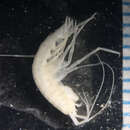Comprehensive Description
provided by Smithsonian Contributions to Zoology
Stygobromus flagellatus (Benedict)
Stygonectes flagellatus (Benedict).—Hoisinger, 1967:115–116 [with references].—Mitchell and Reddell, 1971:59–60.
Stygobromus flagellatus (Benedict).—Karaman, 1974:111.—Holsinger, 1977a:261.
MATERIAL EXAMINED.—TEXAS. HAYS COUNTY: Artesian well in San Marcos, 3 , 5 , 31 Mar 1973 to 1 Nov 1973; 424 , 592 , 306 juvs, and 3 fragments from continuous sampling between 14 May 1974 and 16 Dec 1975; Ezells Cave in San Marcos, 4 , 3 , J. R. Reddell and R. W. Mitchell, 28 Oct 1967; Rattlesnake Cave in San Marcos, 2 , A. G. Grubbs, 9 Mar 1975 and 1 , 1 , 2 May 1975; San Marcos Springs, 10 , 2 , and 15 juvs (from large spring opening), 25 Nov 1975; 9 , 2 (from large pipe spring), 5 Dec 1975; 12 , 2, and 7 juvs (from large pipe spring). 7 Dec 1975; 7 , (from large pipe spring), 19 Jan 1977.
- bibliographic citation
- Holsinger, John R. and Longley, Glenn. 1980. "The subterranean amphipod crustacean fauna of an artesian well in Texas." Smithsonian Contributions to Zoology. 1-62. https://doi.org/10.5479/si.00810282.308
Stygobromus flagellatus: Brief Summary
provided by wikipedia EN
Stygobromus flagellatus, commonly called Ezell's Cave amphipod, is a troglomorphic species of amphipod in family Crangonyctidae. It is endemic to Texas in the United States.
- license
- cc-by-sa-3.0
- copyright
- Wikipedia authors and editors

